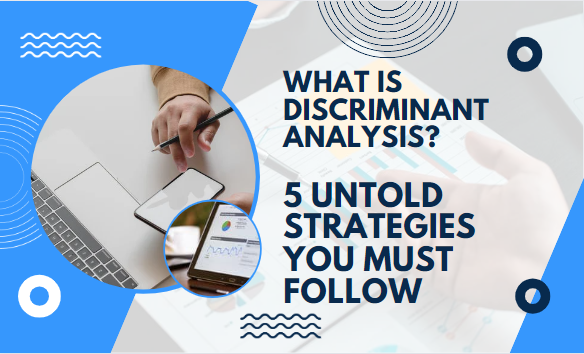Do you know that analysing the data in scientific research is not an easy task? Yes, it isn’t easy to analyse the data and reach a conclusion. Sometimes, you need to use the regression analysis method and, sometimes, the discriminant analysis method. Yes, the later analysis technique is a newly developed data analysis technique being used in scientific research for pattern and theme recognition purposes.
Being a new analysis technique, many of you may not know about this. You may also be unaware of the strategies used to conduct this analysis. So, keeping this in mind, today’s article is dedicated to discriminant analysis. It will define this analysis properly and provide a brief description of its types and the 5 untold strategies to conduct this analysis. So, let’s start the article with the definition and importance of this data analysis type.
What is Discriminant Analysis? Explain With Importance.

The definition of discriminant analysis is clear from the word “discriminate.” As the name suggests, it is a way to discriminate or classify the outcomes of the analysis. It classifies the data and finds a set of predictive equations based on independent variables. Those independent variables are then used to classify the dependent variables or individuals into several groups. There are two possible objectives of this analysis, which are as follows:
- Finding a predictive equation to classify the individuals into groups
- Interpreting the formulated equation to understand the relationship between variables
Why is discriminant analysis important in research? The answer to this question is simple. It is important because by performing this analysis, you, as a researcher, are able to address the complex classification problems. As it develops a predictive equation for the analysis, it also helps the researcher in taking swift decisions about the research problem. So, all these things make it an important analysis.
Types of Discriminant Analysis in Research
From the discussion above, you have a good idea of this analysis and why it is important to conduct. Now, let’s have a look at the types of this analysis which are used in research commonly to categorise individuals into different groups. Hence, a brief description of the types is as follows:
Linear Discriminant Analysis (LDA)
In this type, you often try to analyse a linear combination for the specifications that differentiate two or more than two variables. The independent variable is considered to be normally distributed in this analysis type. You can also hire a cheap dissertation writing service when working on this analysis type for your dissertation.
Quadratic Discriminant Analysis (MDA)
In this type of analysis, the observation or data is classified into groups with the least squared distance. The square distance will never be linear in any case; keep it in mind.
Gaussian Discriminant Analysis (GDA)
The third type of analysis is gaussian, which is aslo called a normal distribution. This distribution is dependent on the mean and standard deviation of the collected dataset. This analysis method is often used when working on AI projects.
Canonical Discriminant Analysis (CDA)
It is the last type of analysis, and it measures the connection or relationship between two unique sets of variables. The two unique sets are divided into two groups called X and Y groups.
5 untold Strategies to Follow When Conducting Discriminant Analysis
Like every other analysis, this analysis also consists of some steps and strategies that you need to follow. Overall, this analysis consists of five strategies. A brief description of all those strategies is as follows;
1- Formulate the Problem
First things first, to start the analysis process, you need to formulate the problem. You must formulate research questions like, “what is the objective of conducting this analysis?” “What is the purpose of doing this analysis?” Once you have defined the purpose, the rest is easy. In the next steps, you just need to identify the variables and categories in which you will place the outcomes of the analysis. So, divide your sample into groups.
2- Find the Discriminant Function
The second strategy is about finding the discriminant function. A discriminant function is a function of several variables that assign samples to a particular group. Normally, the discriminant function is of the following shape:
D = b0 + b1X1 + b2X2 +….+ bkXk
In this function, D is the discriminant score, and ‘b’ represents the weights for the predictors ‘X.’ As a researcher, you already know the X. All you need to do is to estimate the weights or value of b and assign the sample to a particular group.
3- Determine the Significance of the Function
The 3rd step is about determining the significance of the function that you have formulated in step 2. It means that the function should be statistically significant. Now, the question is how you can check the significance. One method to check the significance, which is also the most common, is by using the eigenvalue of the function. Larger eigenvalues of a function mean better discrimination or classification of the samples. So, you must determine the significance of the function.
4- Run the Analysis and Interpret the Results
Step no. 4 tells you to run the discriminant analysis and interpret the results. The coefficient of each predictor in the function tells a lot about its influence on the classification of samples. A predictor with high coefficient values plays an important and influential role in the discriminating ability of the function. You can also study the relationship between the variables when interpreting the analysis results.
5- Assess the Validity of the Results
The last step is to assess the validity of the results of the analysis by cross-checking it using another mathematical method. Once the data is categorised and discriminated, calculate the percentage of correct classifications. This percentage cross-validates the results and discriminated values.
Conclusion
Discriminant analysis is a statistical way to classify the samples into different groups. To do this effectively, you need to follow some strategies which are mentioned above. Two important steps are formulating the problem right and finding the suitable discriminant function. Therefore, you must pay proper attention to these.

